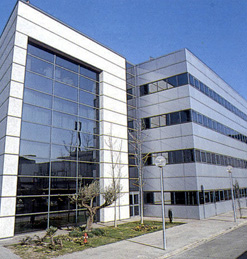The waste heat recovery technology has been tested by these five different prototypes with different variations in power electronics, thermal collector contact surfaces, cooling system and the thermoelectric generators to configure the best option for each type of heat source.
Efficiency is one of the main parameters analysed in each project. This parameter shows how much energy is extracted from waste heat.
The efficiency of the prototype depends on the heat source, the heat collector type and the cooling system applied.
CELSA group produces 2.4 million tons of steel per year. Production is separated into corrugated and smooth round rods, rolled wire, flats rods, squares, angles rods, and structural sections.
The energy recovery system (Heat R-System) installed in the industrial plant that CELSA has in Castellbisbal (Barcelona) makes use of the waste heat generated by radiation in the beam blank cooling area.
The operating cycle of the beam blank production is 24 hours a day, 7 days a week, and the temperature of the heat source is about 600 ºC although the temperature in the metal heat collection plate is about 240 ºC.
The recovery system obtains heat by conduction through the contact between the heat collector of the WHRU and the metal heat collection plate that receives the radiation from the beam blanks. Therefore, the recovery system is non-intrusive.
WHRU modules uses water heat-exchanger (water-block) for their cooling to obtain the maximum temperature difference between the two sides of the Peltier cells. Water is pumped from an internal cooling water line. The water-cooling temperature is about 25 ºC.
In this project, the energy recovery system is based on this type of WHRU:
WHRU – WBCD100


- Cooling system principle: Forced water convention
- Cooling components Cold plate or water heat exchanger (waterblock).
- Heat capture system principle Forced air convection – gas exhaust.
- Thermal collector Plane thermal collector
- Electrical energy generator Thermoelectric generator TEG – Peltier cell
- Peltier cell number 36 cells 40 *40 mm
The main feature of this device is that it groups a set of 36 thermoelectric generators into a single unit. This design was created to group as many thermoelectric generators as possible in the smallest possible space, optimising the ratio of power generated per unit area.
Results
| Thermal collector plate temperature | 200 – 248 ºC |
| Generation area WHRU | 1705,7 cm2 |
| Mean power generated | *32 W |
| Maximum power generated | *40 W |
| Energy generated | *280,32 kWh/year |
| Power density. | *47,62 W/m2 |
| Heat dissipated by the heat source | 685 W |
| Heat flow through Heat R-System by conduction | *1126 W |
| Efficiency | *3,55 % |
To generate more energy, it is necessary to capture the maximum amount of heat flow. This is possible if the system is intrusive and there is contact between the fins of the heat collector and the hot gases. This is not the case in this project.
In CELSA, the system is non-intrusive and the heat is obtained by surface contact between the heat collector and the metal heat collection plate, which receives the heat by radiation and therefore, increases its temperature. However, when the WHRU is in contact with the metal heat collection plate the surface temperature of the heat collector is reduced and, consequently, the efficiency is reduced.
On the other hand, there is a higher heat transfer due to the higher number of mounted Peltier cells.
The action of the forced water cooling system allows a significant temperature differential between the two sides of the Peltier cells, which results in higher electrical power generation, but the efficiency is not as high as if the system were intrusive.
From the standpoint of the installation, the water-cooling system requires a hydraulic loop with a pump. It is essential to ensure a continuous supply of cooling water to avoid damaging the prototype by exceeding the maximum working temperatures of the components. Therefore, installing two pumps instead of one or automating the start-up of the pump when the process starts are options to ensure the water supply. It is also crucial to ensure that all valves are open in the hydraulic circuit.
On the other hand, the quality of the water supply is important. The water must be free of suspended solids to avoid possible clogging that could hinder or prevent the water supply and thus damage the equipment.




